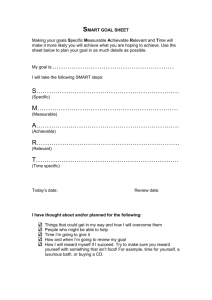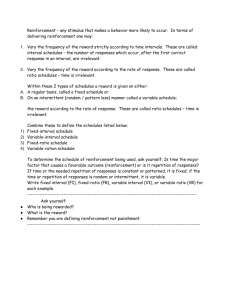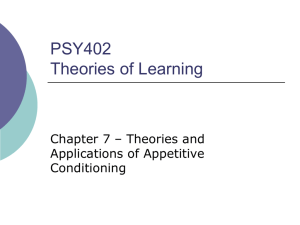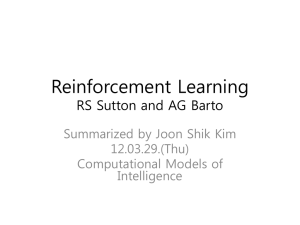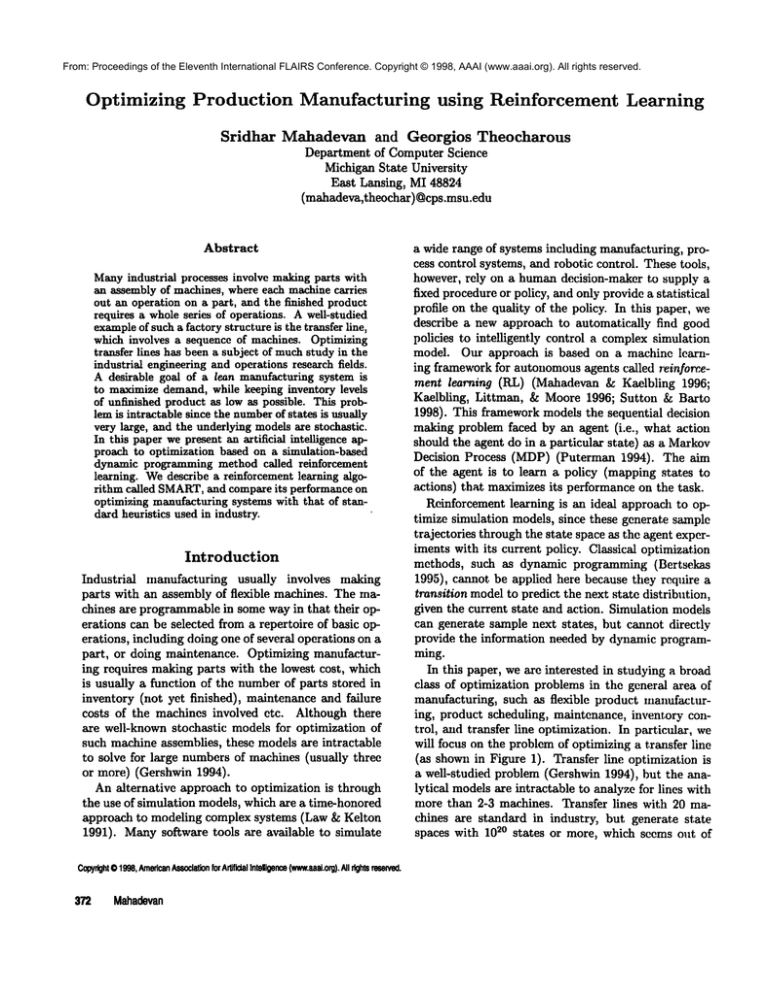
From: Proceedings of the Eleventh International FLAIRS Conference. Copyright © 1998, AAAI (www.aaai.org). All rights reserved.
Optimizing
Production
Manufacturing
using
Reinforcement
Learning
Sridhar Mahadevanand Georgios Theocharous
Department of Computer Science
Michigan State University
East Lansing, MI 48824
(mahadeva,theochar) @cps.msu.edu
Abstract
Manyindustrial processes involve makingparts with
an assembly of machines, where each machinecarries
out an operation on a part, and the finished product
requires a whole series of operations. A well-studied
exampleof such a factory structure is the transfer line,
which involves a sequence of machines. Optimizing
transfer lines has been a subject of muchstudy in the
industrial engineering and operations research fields.
A desirable goal of a lean manufacturing system is
to maximizedemand, while keeping inventory levels
of unfinished product as low as possible. This problem is intractable since the numberof states is usually
very large, and the underlying modelsare stochastic.
In this paper wepresent an artificial intelligence approach to optimization based on a simulation-based
dynamic programming method called reinforcement
learning. Wedescribe a reinforcement learning algorithm called SMART,
and compareits performance on
optimizing manufacturing systems with that of standard heuristics used in industry.
Introduction
Industrial
manufacturing usually involves making
parts with an assembly of flexible machines. The machines are programmablein some way in that their operations can be selected from a repertoire of basic operations, including doing one of several operations on a
part, or doing maintenance. Optimizing manufacturing requires making parts with the lowest cost, which
is usually a function of the number of parts stored in
inventory (not yet finished), maintenance and failure
costs of the machines involved etc. Although there
are well-known stochastic models for optimization of
such machine assemblies, these models are intractable
to solve for large numbers of machines (usually three
or more) (Gershwin 1994).
An alternative approach to optimization is through
the use of simulation models, which are a time-honored
approach to modeling complex systems (Law & Kelton
1991). Manysoftware tools are available to simulate
Copyright
O1998,
Amedcan
Association
for ArtificialIntelligence
(www.aaai.org).
All rightsresen~l.
372 Mahadevan
a wide range of systems including manufacturing, process control systems, and robotic control. These tools,
however, rely on a human decision-maker to supply a
fixed procedure or policy, and only provide a statistical
profile on the quality of the policy. In this paper, we
describe a new approach to automatically find good
policies to intelligently control a complex simulation
model. Our approach is based on a machine learning framework for autonomousagents called l~i.n/o~ement learning (RL) (Mahadevan & Kaelbling 1996;
Kaelbling, Littman, & Moore 1996; Sutton & Barto
1998). This framework models the sequential decision
making problem faced by an agent (i.e., what action
should the agent do in a particular state) as a Markov
Decision Process (MDP) (Puterman 1994). The
of the agent is to learn a policy (mapping states to
actions) that maximizes its performance on the task.
Reinforcement, learning is an ideal approach to optimize simulation models, since these generate sample
trajectories through the state space as the agent experiments with its current policy. Classical optimization
methods, such as dynamic programming (Bertsekas
1995), cannot, be applied here because they require
transition model to predict the next state distribution,
given the current state and action. Simulation models
can generate sample next states, but cannot directly
provide the information needed by dynamic programming.
In this paper, we are interested in studying a broad
class of optimization problems in the general area of
manufacturing, such as flexible product manufacturing, product scheduling, maintenance, inventory control, and transfer line optimization. In particular, we
will focus on the problem of optimizing a transfer line
(as shownin Figure 1). Transfer line optimization
a well-studied problem (Gershwin 1994), but the analytical modelsare intractable to analyze for lines with
more than 2-3 markdnes. Transfer lines with 20 machines are standard in industry, but generate state
spaces with 102° states or more, which seems out of
the realm of possibility for optimization using analytical models (as noted by (Gershwin 1994)). We
present empirical results comparing the performance
of an average reward reinforcement learning algorithm
called SMART
(Mahadevan et al. 1997) on optimizing
such a transfer line, and compare it with a well-known
heuristic from the Literature called Kanban, originally
developed by Toyota Motor company (Shingo 1989;
Bonvik & Gershwin 1996).
Figure h A transfer line models an assembly line operation in many factories, where a sequence of machines
(M) make parts, that are isolated by product buffers
(B). The machines are unreliable, and may fail occasionally. The problem is to optimize the throughput
of the transfer line, while minimizing the in-product
inventory, and minimizing failures.
The approach proposed in this paper can be applied
to manyother problems, including flexible manufacturing, product switching, ATMoptimization, admission
control in queues, and so on.
Discrete-Event Sequential
Decision-Making Model
Decision-making in man}’ domains can be abstractly
viewed as follows. At each step, the agent perceives
(perhaps imperfectly) the underlying environment
being in one of a (possibly very large, but finite) set
of states. The agent can choose one of a set of finite
actions in a given state, and carry it out. The action
modifies the environment in some way (or transports
the agent around), thereby modifying the perceived
state into a new state. Much recent work in AI on
autonomous agents, ranging from reinforcement learning (Sutton & Barto 1998), to robotics (Simmons
Koenig 1995), has adopted this framework.
For the purpose of optimizing simulation, we need
to extend the discrete-time framework to a discreteevent framework, thereby generalizing it in two ways.
Time is explicitly modeled as a continuous variable,
but the agent observes the environment and makes
decisions only at certain discrete points (or decision
epochs). In between these epochs, the state of the system can be changing in some complex way, but these
changes may not provide the agent with any additional
information. Furthermore, actions take non-constant
time periods, modeled by some arbitrary time distribution. It is not possible to modelthe optimization of factory processes as a discrete-time MDP,without drastic
loss of information (for example, Poisson demandprocesses or failure distributions require using real-valued
stochastic time distributions).
This is well knownin
the simulation community, since discrete-event models have been used as the basis for simulation studies
in a multitude of domains, ranging from manufacturing, queueing, networking, and transportation (Law
Kelton 1991).
Formally, the evolution of the environment at decision epochs can be modeled as a semi-Markov decision process (SMDP)(Puterman 1994). It is termed
a semi-Markov model, because the transition depends
not only on the current state and action, but also on
how long the system has been in the current state. An
SMDPis defined as a five tuple (S,A,P,R,F), where
S is a finite set of states, Ais a set of actions, P is a set
of state and action dependent transition probabilities,
R is a reward function, and F specifies the probability distribution of transition times for each state-action
pair. P(y [ x., a) denotes the probability that action a
will cause the system to transition from state x E S to
y E S. This transition probability function describes
the transitions at decision epochs only.
The reward function for SMDP’sis more complex
than in the MDPmodel. In addition to the fixed
reward k(x,a), accrued due to an action taken at a
decision epoch, an additional reward may be accumulated at rate c(y,z, a) for the time the natural process remains in state y between the decision epochs.
Note that the natural process may change state several
times between decision epochs, and therefore, the rate
at which the rewards are accumulated between decision
epochs may vary. For example, in our experiments, the
average size of the inventory level is translated into a
rate cost that is computedas the area under the buffer
size curve. Wewill describe the cost model in more
detail below.
Reinforcement learning infers the optimal policy indirectly by inferring instead a value function (mapping
states or state-action pairs to real numbers). Policies determine a value function based on an optimality
metric, which is usually either a discounted model, or
an average-reward model. Wewill primarily use the
average-reward model in our work.
Value Functions
SMDPs
for
Average
Reward
The expected reward between two decision epochs,
given that the system in state x, and a is chosen at
the first decision epoch, maybe expressed as
(/o
r(z, a) = k(z, a) + E~
cCWt, x, a)dt
(1)
Reinforcement
Leaming
373
wherer is thetransition
timeto theseconddecision
epoch,
andWt denotes
thestateof thenatural
process.
Now,starting
fromstatex at time0,andusinga policy
Ir forn decision
epochs
untiltimet, theexpected
total
rewardcan be expressed
as
=
+ kC=,,,a,,)
q=O
(2)
wherek(xn,an)isthefixedreward
earned
at thenth
decision
epoch,andc(y,xn,an)is therateat which
rewardis accumulated
fromthe nth to the(n + 1)th
decisionepoch.The averagerewardp= for a policy
7r canbe defined
by takingthelimitinferior
of the
ratioof the expected
totalrewardup untilthe nth
decision
epochto theexpected
totaltimeuntilthenth
epoch.So theaverage
rewardof a policyp"(x)can
expressed
as theratio
lira
n-~oo
n T,
E;{E,=0
i}
is the utility of doing action a in state x. These action
values can be learned by running a simulation model
of the manufacturing domain, and using a feedforward
neural net to approximate the action values.
The SMART
algorithm can be derived straightforwardly from the Bellman equation for SMDP’s(Equation 5). First, we reformulate Equation 5 using the
concept of action-values. The average-adjusted sum of
rewards received for the non-stationary policy of doing action a once, and then subsequently following a
stationary policy ~r can be defined as
M~(x, a) = r(x, a)-p~y(x,
zES
b
(6)
Thetemporal difference betweenthe action-values of
the current state and the actual next state is used to
update the action values. In this case, the expected
transition time is replaced by the actual transition
time, and the expected reward is replaced by the actual immediate reward. Therefore, the action values
1are updated as foUows:
(3)
Foreachtransition,
theexpected
transition
timeis
defined as:
t E Q(dt, z I x, a) (4)
-’ES
for each x E S, and a E A.
The Bellman optimality equation for unichain average reward SMDP’s is analogous to that for the
discrete-time model, and can be written as
R(x,a)
SMART: A Simulation-based
Average-Reward Reinforcement
Learning Algorithm
We now describe an average-reward algorithm called
SMART(for Semi-Markov Average Reward Technique), which was originally described in (Mahade~’an
et al. 1997). This algorithm is based on representing
the value function using action values R(x, a), which
- pT + maxR(z,b))b
p = E =o
E;=o
(5)
Here, V* is the optimal value function and p* is the
optimal average reward. Note that we are assuming
unichain SMDP’s, where the average reward is constant across states. Manyreal-world SMDP’s,including the elevator task (Crites & Barto 1996) and the
production inventory task and transfer line problems
described below, are unichain.
~- (rimm(X,a)
(7)
where ri,,,~(x,a)
is the actual cumulative reward
earned between decision epochs due to taking action
a in state x, z is the successor state, p is the average reward, and a,~ is a learning rate parameter. Note
that p is actually the reward rate, and it is estimated
by taking the ratio of the total reward so far, to the
total simulation time.
V*(x)="ax r(x’a) -p*y(x’a) +E Pzz(a)V*(z))zes
374 Mahadevan
a)+~ Pzz(a) ~ (z , b
(8)
whererimm(xn, an) is the total reward accumulated
betweenthe nth, and (n -t- 1)th decision epochs,and
rn is the corresponding transition time. Details of the
algorithm axe given in Figure 2. The learning rate an
and the exploration rate Pn are both decayed slowly
to 0 (we used a Moody-Darken search-then-converge
procedure).
Value
Function
Approximation
in
SMDP’s
In most interesting problems, such as the transfer line
problem in Figure 1, the numberof states is quite large,
and rules out tabular representation of the action values. One standard approach, which we followed, is
to use a feedforward net to represent the action value
tWeline the notation u 2,-. v as an abbreviation for the
stochastic approximationupdate rule u ~-- (1 - e~)u + av.
1. Set decision epoch n - 0, and initialize action values
Rn(x, a) = O. Choosethe current state x arbitrarily.
Set the total reward c,~ and total time tn to 0.
2. While n < MAX_STEPSdo
(a) With high probability p,~, choose an action a that
maximizes R,~(x,a), otherwise choose a random
action.
(b) Perform action a. Let the state at the next decision epoch be z, the transition time be r, and rimm
be the cumulative reward earned in this epoch as
a result of taking action a in state x.
(c) Update Rn(x, a) using
P~+l(x,a)
(r ,,.m-pnr +
¯ Demandarrival
process
foreachproduct
i is Poisson
¯ Productiontime for each producthas a Gamma
(di,Ai)distribution
¯ Timebetween
failures
hasa Gamma(k,/~)distribution
m~P~(z,b))
(d) In case a nonrandom action was chosen in step
2(a)
¯ Timerequired
formaintenance
hasa Uniform
(a,b)
distribution
¯ Time for repair has a Gamma(r, &) distribution
¯ Update total reward cn ( cn -{- rimm
¯ Update total time tne--- tn -{- ~"
¯ Update average reward p~ <
(e) Set current state x to new state z, and n +- n-t-1.
Figure2:
SMDP’s.
on optimizing single machines with SMART
(Mahadevan et al. 1997). A single fiexible manufacturing machine can make several parts, each of which go into a
separate buffer. The transfer line generalizes this example to several interconnected machines. The system
we consider consists of a machine capable of producing 5 different products. The main parameters for the
system
areestimated
as follows:
The SMART algorithm for unichain
function (Crites & Barto 1996). Equation 7 used
SMART
is replaced by a step which involves updating the the weights of the net. So after each action
choice, in step 2(c) of the algorithm, the weights of the
corresponding action net is updated according to:
(9)
where
c(x,z,a,rimrn,
~)isthetemporal
difference
error
[rimm(x,a) -- pnT-~ ma=t~(z,b,4~)
P~(x,a,~)]
and ~ is the vector of weights of the net, an is the
learning rate, and V~Rn(x,a, ~) is thc vector of partial
derivatives of R,~(x, a, ~b) with respect to each component of ~b.
Experimental
Results
Single machine optimization
Wenow present detailed results of the SMART
algorithm for optimization of manufacturing processes. To
set the context, we begin by reviewing our earlier work
The reinforcement learning algorithm is implemented using CSIM,a commercially available discreteevent simulator (see Figure 3). An example result of using the reinforcement learning algorithm to
optimize a single flexible manufacturing machine is
shown in Figure 4. As the figure shows, the production/maintenance policy learned by reinforcement
learning is muchbetter than the ones derived from two
heuristic procedures.
Transfer
Line Optimization:
Multiple
machines
We now present results of optimizing a 3 machine
transfer line, as shownin Figure 1, and compare it to
the performance of a standard well-accepted heuristic
called Kanban. The goal of optimizing a transfer line
is to maximize satisfied demand(which means delivering finished product to customers, any time a such a
demand occurs), while keeping the inventory levels as
low as possible.
The Kanban heuristic:
This heuristic
was developed at the Toyota Motor company, which is usually
credited as an originator of the concept of lean manufacturing (Shingo 1989). The basic idea behind the
heuristic is illustrated in Figure 5. The heuristic uses
the concept of cards (or Kanbans) that circulate between a buffer and the immediate upstream machine,
and are a signal for a machineto stop or start production. Essentially, in this method a machine produces
until its output buffer is full. If a unit of finished product is consumedby demand, the last machine receives
a Kanbancard authorizing it to produce an additional
Reinforcement
Learning375
SMART
vs CORand AR: System 1
0.4 - ¯ ¯
’SMART-FIXED".- ¯
Aft" -----"
......................
,COR,
I ..
|
¯
~ ..... ....................................................................
0.2
J
0 ......................................
-0.2
.
......................
~,
-V...,
..............................................
"........
i
-{},4
i
200000
0
I
Figure 3: The SMARTreinforcement
learning algorithm is implemented using CSIM, a commercial
discrete-event simulator. CSIMallows construction of
simulation modelsof arbitrary size, since it is directly
based on the C language.
part. This machine then picks up its raw materials
from the buffer immediately behind it, which releases
the Kanban card for that part. This way, information
flows back upstream to all the machines for them to
produce one additional part.
The following cost model for optimizing a transfer
line was adopted. Repairs are modeled as incurring a
cost of -1000. Each unit of satisfied demandis worth a
positive reward of 10. In addition, there is a continual
rate cost based on the average inventory levels, which
is scaled by 0.1. In our experiments, each of the three
machines receives the same reward.
Table 1 compares the performance of the SMART
algorithm with the Kanban heuristic. The table shows
the total inventory levels needed by SMART
and Kanban for various target demand levels. In each case,
the fill rate (percentage of demandsatisfied) was about
98%, indicating that most of the demandwas satisfied.
As the table shows, SMART
outperforms the Kanban
heuristic in needing muchfewer items in the inventory.
Target Demand SMARTI Kanban
106.7
135.27
0.2
100.69
117.3
0.5
85
101.15
0.6
Table 1: Comparison of Total Average Inventory Levels of SMART
with Kanban heuristic.
376 Mahadevan
i
400000
i
600000
Slmuk~m
"Nine
i
800000
Figure 4: All curves show median-averaged costs of
production of 5 parts using an unreliable machine. The
top curve corresponds to the policy learned by the reinforcement learning algorithm. The bottom two correspond to fixed policies representing two heuristic methods.
...
""
"........
. ......
..
." " "" ""...
Figure 5: Diagram showing the Kanban heuristic
icy for optimizing a transfer line.
pol-
Inventory levels are of course, only part of the overall improvement offered by SMART.In particular, because SMART
actually learn a maintenance policy in
addition to a production policy, the total number of
failures is far fewer when using SMART.Table 2 compares the number of failures incurred under SMART
and under Kanban. Note that since the Kanbanheuristic does not incorporate any maintenancepolicy, it will
obviously incur a far higher numberof failures, as the
table shows. The higher number of failures implies
that the Kanbanheuristic will result in a muchlower
average reward, as shown in Figure 6.
I Target Demand I SMARTKanban
0.2
843
2878
0.5
1880
6458
0.6
2992
8980
Table 2: Comparisonof Total Numberof Machine Failures for SMART
with Kanban heuristic.
Limitations
and Future
Work
The results described in this paper should be viewed as
preliminary, particularly those for optimizing a transfer line. Weare currently running additional experi-
SMARTremus Kanbln
..~:....... ."
~..........
l ................
¯. ......
¯ y:.:;j:?. ....
~ .................
7
.............
a~ =
~ ......
¯
:
i
I
~lmnl~
n’._-_-::.- -¯!
¯:
¯,
: .......I- ........................ ~-......
s ...... , .........
, ......."...............
~.......
~..............
i- ..........
|
Bonvik, A., and Gershwin, S. 1996. Beyond kanban:
Creating and analyzing lean shop floor control problems. In Conference on Manu/acturing and Service
Operations Management.
J I
I ......
¯
~sh~,~.:
:.: ..............~:......4-..............
"-~~,
2 .....
= .............
-r ..... ~ ................
~ .................
Boutilier, C.; Dearden, R.; and Goldszmidt, M. 1995.
Exploiting structure in policy construction. In Proceedings of the Fourteenth IJCAI.
1
Crites, R., and Barto, A. 1996. Improving elevator
performance using reinforcement learning. In Neural
Information Processing ~ystems (NIPS).
¯
........
..
0 -1
0
!
,
2000
I
i;
4.
,
i
" i
i
.I
~,
....
1
-I
|
,
4000
6000 8(X)O 10000 12000 14000 18000
Numberof Declslon EI~t~
Figure 6: This figure compares the average reward of
the policy learned by SMART
with that produced by
the Kanbanheuristic.
ments, which we expect to report during the presentation of this paper. Here, we briefly discuss the nature
of the additional experiments being planned.
There are several additional heuristics that have
been developed, such as the CONWIP
(constant workin-process)
strategy (Spearman, Woodruff, & Hopp
1990), as well as hybrid methods (Bonvik & Gershwin 1996) which combines a kanban with a CONWIP
strategy. Weplan to compare SMART
to these other
heuristics.
Another research direction is to investigate hierarchical reinforcement learning methods to scale to large
transfer lines, as well as generalizations of transfer lines
to job shops and flow shops. Hierarchical optimization of such assemblies has been theoretically investigated in depth (Sethi & Zhang 1994), but however,
the computational study of such optimization methods is limited. There is currently muchinterest in the
reinforcement learning literature on hierarchical methods (Parr & Russell 1998), but there has yet been
demonstrable results on interesting large scale problems. Webelieve the factory optimization domain to
be an excellent testbed for hierarchical reinforcement
learning algorithms. Finally, each machine is given the
same global reward, and we plan to conduct comparative experiments where each machine is given different
local rewards.
Acknowledgements
Gershwin, S. 1994. Manufacturing Systems Engineering. Prentice Hall.
Kaelbling, L.; Littman, M.; and Moore, A. 1996. Reinforcement learning: A survey. Journal o/ Artificial
Intelligence Research 4.
Law, A., and Kelton, W. 1991. Simulation Modeling
and Analysis. New York, USA: McGraw-Hill.
Mahadevan, S., and Kaelbling, L. P. 1996. The NSF
workshop on reinforcement learning: Summaryand
observations. AI Magazine 1(12):1-37.
Mahadevan,S.; Marchalleck, N.; Das, T.; and Gosavi,
A. 1997. Self-improving factory simulation using
continuous-time average reward reinforcement learning. In Proceedings of the Fourteenth International
Machine Learning Conference. Morgan Kaufmann.
202-210.
Parr, R., and Russell, S. 1998. Reinforcement learning
with hierarchies of machincs. In Advances in Neural
Information Processing Systems (NIPS).
Puterman, M. L. 1994. Markov Decision Processes.
NewYork, USA: Wiley Interscience.
Sethi, S., and Zhang, Q. 1994. Hierarchical Decision Making in Stochastic Manu/acturing Systems.
Birkhauser.
Shingo, S. 1989. A Study of t.he Toyota Production System from an Industrial Engineering Viewpoint. Productivity Press.
Simmons, R., and Koenig, S. 1995. Probabilistic robot navigation in partially observable environments. In Proceedings of the IJCAI, 1080-1087.
This research is supported in part by an NSF CAREER
Award Grant No. IRI-9501852.
Spearman, M.; Woodruff, D.; and Hopp, W. 1990.
CONWIP:An alternative
to kanban. International
Journal of Production Research 28(5):879-894.
References
Sutton, R., and Barto, A. 1998. Reinforcement Learning: An Introduction. MITPress.
Bertsekas, D. 1995. Dynamic Programming and Optimal Control. Belmont, Massachusetts: Athena Scientific.
Reinforcement
Leaming
377


